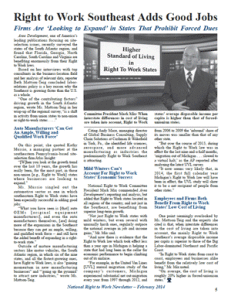Will Team Biden Weaponize Workers’ Pensions?
Big Labor abuse of worker pension and benefit funds as a means of advancing union bosses’ self-aggrandizing policy objectives is a familiar phenomenon.
 Firms Are ‘Looking to Expand’ in States That Prohibit Forced Dues
Firms Are ‘Looking to Expand’ in States That Prohibit Forced Dues
(click to download newsletter)
Area Development, one of America’s leading publications focusing on site-selection issues, recently surveyed the states of the South Atlantic region, and found that Florida, Georgia, North Carolina, South Carolina and Virginia are benefiting enormously from their Right to Work laws.
Based on her interviews with top consultants in the business-location field and her analysis of relevant data, reporter Beth Mattson-Teig concluded labor- relations policy is a key reason why the Southeast is growing faster than the U.S. as a whole.
“One of the contributing factors” driving growth in the South Atlantic region, wrote Ms. Mattson-Teig in her wrap-up of the regional survey, “is a shift in activity from union states to non-union or right-to-work states . . . .”
Auto Manufacturers ‘Can Get An Ample, Willing and Qualified Work Force’
On this point, she quoted Kathy Mussio, a managing partner at the southeastern Pennsylvania-based site-selection firm Atlas Insight:
“[W]hen you look at the growth trend over the last 10 years, the growth has really been, for the most part, in those non-union [e.g., Right to Work] states where businesses are looking to expand.”
Ms. Mussio singled out the automotive sector as one in which southeastern Right to Work states have been especially successful in adding good jobs:
“What you have seen is [that] auto OEMs [original equipment manufacturers], and even the auto manufacturers themselves, [are] doing more of the expansions in the Southeast because they can get an ample, willing, and qualified work force — and still have the added benefit of expanding in a right-to-work state.”
Outside of mature manufacturing sectors like motor vehicles, the South Atlantic region, in which six of the nine states, and all the fastest-growing ones, have Right to Work laws, is also “gaining momentum in new manufacturing businesses” and “‘going up the pyramid’ to attract new industries,” wrote Ms. Mattson-Teig.
Citing Andy Mace, managing director of Global Business Consulting, Supply Chain Solutions at Cushman & Wakefield in York, Pa., she identified life sciences, aerospace, and more advanced manufacturing as industries the predominantly Right to Work Southeast is attracting.
Mild Winters Can’t Account For Right to Work States’ Economic Success
National Right to Work Committee President Mark Mix commended Area Development’s reporting and analysis, but added that Right to Work states located in all regions of the country, and not just in the Southeast, are benefiting from superior long-term growth.
“Not just Right to Work states with mild winters, but even several with unusually harsh ones, regularly outpace the national average in job and income gains,” Mr. Mix said.
“And now there is evidence that the Right to Work law which took effect less than a year ago in Michigan is helping a state that had long been in the cellar for economic performance to begin climbing out of its malaise.
“For example, in the United Van Lines [UVL] annual migration study of the company’s customers, Michigan experienced substantial net out-migration every year from 1997 through 2012, and from 2006 to 2009 the ‘inbound’ share of its moves was smaller than that of any other state.
“But over the course of 2013, during which the Right to Work law was in effect for the last nine-and-a-half months, ‘migration out of Michigan . . . slowed to a virtual halt,’ as the AP reported after analyzing the latest UVL survey.
“It now seems very likely that, in 2014, the first full calendar year Michigan’s Right to Work law will have been in effect, the UVL study will show it to be a net recipient of people from other states.”
Employees and Firms Both Benefit From Right to Work States’ Low Cost of Living
One point seemingly overlooked by Ms. Mattson-Teig and the experts she cited is that, when interstate differences in the cost of living are taken into account, the mainly Right to Work Southeast’s average disposable income per capita is superior to those of the Big Labor-dominated Northeast and Pacific Coast.
“In Right to Work states from coast to coast, employees and businesses alike benefit from the relatively low cost of living,” Mr. Mix noted.
“On average, the cost of living is roughly 20% higher in forced-unionism states.”

Big Labor abuse of worker pension and benefit funds as a means of advancing union bosses’ self-aggrandizing policy objectives is a familiar phenomenon.

Leaked CTU Proposals Won’t Do Anything to Improve Schools’ Poor Performance

What impact does handing a union monopoly power to deal with your employer on matters concerning your pay, benefits, and work rules have on your pay?